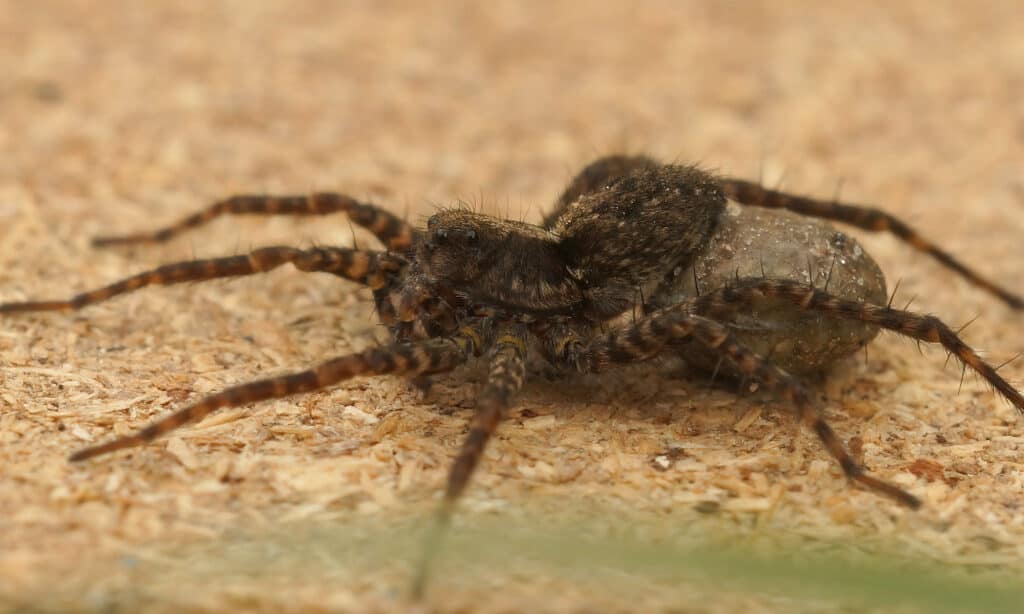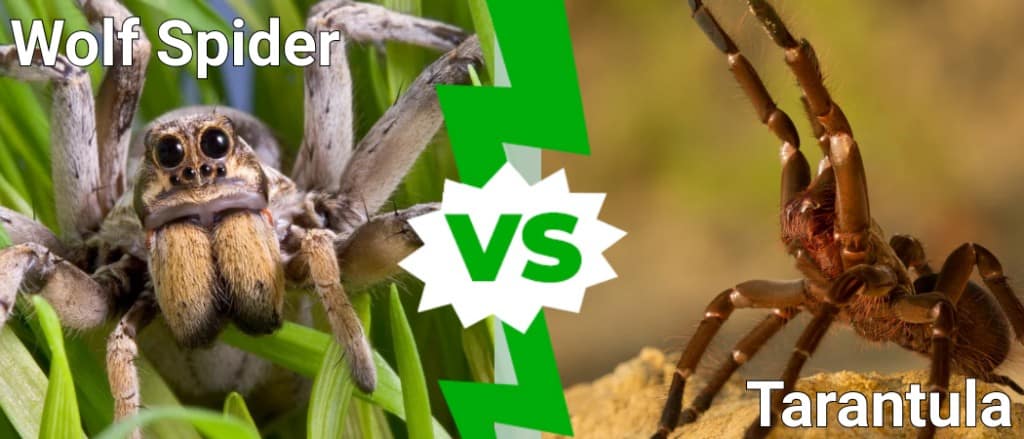Although most people enjoy getting close to their pets, wildlife is best left alone. Interacting with wild animals like wolf spiders and snakes comes with a risk, from scratches and bites to contracting an animal-borne disease.
One of the most common concerns about human-wildlife interactions is what to do if you get bitten by an animal. Let’s find out everything about wolf spider bite and treatment.
What Is a Wolf Spider?

Wolf spiders are large, hairy members of the
Lycosidaefamily.
©Cornel Constantin/Shutterstock.com
Wolf spiders are large and hairy members of the Lycosidae family. There are more than 2,800 species of wolf spiders. Most of them vary in appearance but share several common features. For instance, most species are nocturnal predators.
Wolf spiders rely on their excellent vision to locate prey and avoid predators and depend on their ability to camouflage for hunting and protection. Wolf spiders don’t spin webs but prefer chasing prey over short distances or ambushing it near the mouth of a burrow.
They are typically black, brown, or gray with light orange or tan stripes along their bodies and radiating out from the center of the back. They range in body size between 0.4 and 1.38 inches (10 and 35 mm).
Wolf spiders are considered beneficial since they play an important role in controlling the population of insects and other pests.
Where Do Wolf Spiders Live?
Wolf spiders can be found around the world, living in a variety of habitats ranging from coastal to inland ecosystems. These include wet coastal forests, alpine meadows, shrublands, woodland, suburban gardens, and people’s houses.
Their habitat is dependent on which species of wolf spider it is. Some have specific habitat needs such as montane herb fields or stream-side gravel beds. Others are in arid areas, where they live in turrets. And still more are “wanderers,” who move from habitat to habitat.
As there are more than 200 species native to North America, it’s not uncommon to see wolf spiders in many homes. The largest wolf spider species in the U.S. is Hogna carolinensis, and is the state spider of South Carolina.
How Long Do Wolf Spiders Live?
Generally, wolf spiders live 1-2 years, often up to 3 years. Their lifespan varies depending on the species of wolf spider, gender, and environment. Male wolf spiders do not live as long as females, often a year or so less, and many die shortly after mating.
Wolf spiders’ resilience and ability to adapt to their environments help them survive in the wild against threats from predators and lack of food.
In captivity, or as pet, a wolf spider may live up to 3 years longer than those in the wild.
Are Wolf Spiders Dangerous?

A wolf-spider bite is not considered dangerous to humans.
©Brett Hondow/Shutterstock.com
Wolf spiders don’t bite unless continually provoked or cornered. They are quite timid creatures that prefer escaping from humans instead of attacking. In addition, their bites are not considered dangerous to humans, so don’t panic if you’re bitten by one. However, it’s possible to have an allergic reaction to wolf spider venom. They have fangs that can cause swelling and itching.
The venom composition of wolf spiders remains unknown, and they have been implicated in necrotic arachnidism without acceptably documented verifications. A few studies show that a wolf spider’s venom lacks cutaneous necrosis. One of the main reasons there has been limited research on wolf spider venom is the infrequent nature of exposure to wolf spider bites.
Nevertheless, reports from most parts of the world show that wolf spider bites cause skin damage. For example, a well-documented case of a 20-year-old male victim of a wolf spider bite confirmed the development of cutaneous erythema with ulceration following the bite.
In a few cases, a wolf spider bite can cause the most extreme allergic reaction known as anaphylaxis. This could be potentially life-threatening and requires immediate medical attention. For this reason, it’s important to observe the victim of a wolf spider bite for a few hours in case of signs of allergic reactions.
What Are the Symptoms of a Wolf Spider Bite?

Wolf spider bites are similar to other bug bites.
©HWall/Shutterstock.com
Wolf spider bites are very similar to other bug bites. Signs and symptoms vary across individuals, but many people usually notice a red bump that appears swollen and itchy. In most cases, you may not be able to determine what bit you unless you saw the wolf spider biting you.
If any of the following symptoms follow the bite, seek immediate medical care:
- Headache or feeling dizzy
- Nausea and vomiting
- Sweating
- Fever
- Difficulty breathing
- Cramping or having a tight muscle around the bitten area
- Itching
- Weakness or uncontrollable shaking
- A bump that keeps increasing in size
- A red line that extends from the bite
Get medical help right away if the symptoms do not improve.
How to Manage and Treat Wolf Spider Bites
Take the following measures to lessen the discomfort if a wolf spider bites you:
- Wash the bite area using soap and warm water.
- Apply an ice pack or cold compress on the wound to reduce swelling and pain.
- Take anti-inflammatory drugs to reduce swelling. Antihistamines may also help alleviate itchiness.
- Avoid scratching the bite, as it may increase the risk of infection.
- Continue observing the wound for a few hours for any sign of anaphylactic or allergic reaction.
Contact your doctor if you notice any warning signs of anaphylaxis, such as difficulty breathing, tongue swelling, and constant wound swelling. Your doctor may:
- Prescribe antibiotics if secondary infections are suspected.
- Prescribe stronger antihistamines to alleviate itchiness.
- In rare cases, the doctor may recommend surgery if the wound is deep with a prolonged severe infection that continually worsens despite treatment.
- Recommend tetanus vaccination for added protection.
Controlling Wolf Spiders
According to pest control experts at Pest Guide, wolf spiders are typically not aggressive. This means they are only likely to bite if they are trapped against your skin or feel threatened. So the best way to prevent a wolf spider bite is to avoid handling it.
If leaving them be and staying out of their sight as much as possible is not an option, then you may need to figure out how to eliminate wolf spiders from your property.
Taking simple precautions can help prevent wolf spider bites, especially in areas best known to harbor the largest population of wolf spiders: clear clutter and junk around your home to eliminate hiding places. Avoid stacking firewood behind the house, and seal all cracks and crevices around pipes, the attic, and many other places. Consider removing furniture slipcovers and long draperies that reach the floor since they may conceal wolf spiders.
Take the following measures to help control wolf spider activity inside your home:
- Vacuum your house daily for at least one week.
- Always ensure that all screens and weather-stripping elements around windows and doors are secure.
- Use sealed plastic storage containers to keep away wolf spiders.
- Use sticky traps to monitor wolf spider populations inside buildings.
Never crush a wolf spider; given how fast they are, you can get bitten if you miss it.
Wolf Spider vs Tarantula

What if the spider that bit you wasn’t a wolf spider but another species? Could it have been a tarantula? Both have a reputation for being dangerous although they are both relatively harmless to humans.
It can be easy to confuse the two, but the main differences between wolf spiders and tarantulas are their size, length of their hair, and color.
At 1.2 inches long at most, wolf spiders are smaller than tarantulas, which can grow to 2-4 inches. The hairs on the body of the wolf spider are shorter than the tarantula’s. While wolf spiders are light brown, tarantulas are colored dark brown, black, and other shades depending on the species.
Additionally, wolf spiders’ eyes are generally bigger and more visible than that of the tarantula, whose eyes are often covered by their hair. For more help differentiating between these two spider species go here.
The photo featured at the top of this post is © viktori-art/Shutterstock.com
Sources
- Spider Identifications, Available here: https://spideridentifications.com/wolf-spiders
- , Available here: https://vtechworks.lib.vt.edu/bitstream/handle/10919/97165/ENTO-346.pdf?sequence=1
Thank you for reading! Have some feedback for us? Contact the AZ Animals editorial team.






